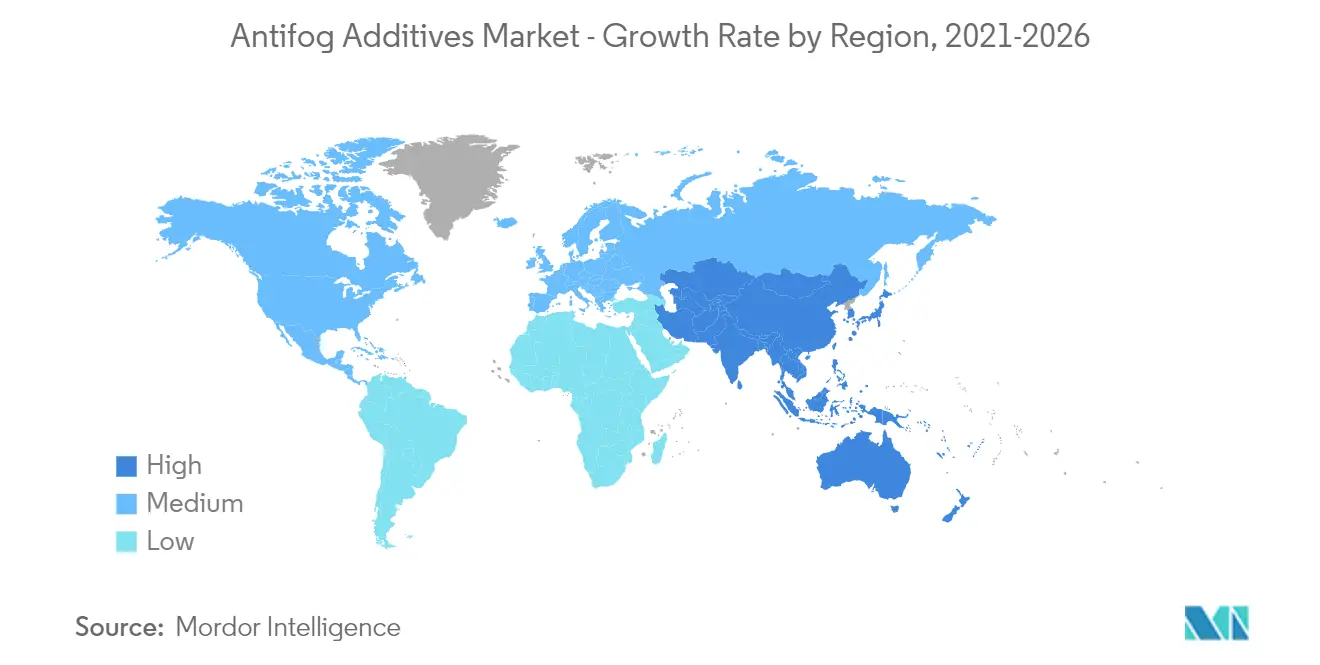Market Trends of Antifog Additives Industry
This section covers the major market trends shaping the Anti-Fog Additives Market according to our research experts:
Increasing Demand from Packaging Films Application
- Fogging phenomenon occurs when freshly packed food items are placed in refrigerated storage. Fogging can be most commonly seenwhen there is a temperature differential between the outside and inside of an enclosed atmosphere. To overcome this problem, anti-fogs are often employed to control the condensation of water in the packaging.
- Antifog additives are primarily used in the production of polymer films to induce an antifogging property in them, which are further used for the packaging of food items, such as vegetables, fruits, breads, among others.
- Anti-fog additives lower the surface tension of the film surface and allow the water droplets to spread into a thin film and flow off from the film. They help in achieving higher transparency and ensure that water is not collected at the bottom of packaging, which could shorten shelf life of the product.
- In food-packaging, the antifog additive enhances product appeal and shelf life. When food is packed in a film where water droplets can form, it will aid to damage produce and the presence of water will allow the produce to rot.
- Additionally, anti-fogging additives benefit food packaging by maintaining its clarity and transparency so that its contents can be clearly seen by the consumer at the point of sale. By adding anti-fogging additives to food packaging films, condensed water droplets are spread into a thin transparent layer rather than remaining droplets. In general, food packaging only requires short-term anti-fogging performance that lasts the lifetime of the packaged food.
- In the Asia-Pacific region, there has been an increase in the acceptance of packaged food. The packaging industry is also poised to expand, thus, supporting the growth of plastic additives in the region. China has the second-largest packaging industry in the world. The country is expected to witness consistent growth during the forecast period, owing to the rise of customized packaging in the food segment, along with increasing exports.
- Owing to all these factors, the demand for antifog additives in the packaging films sector is projected to grow in the coming years.

Asia-Pacific Region to Dominate the Market
- The growing awareness about the benefits of using antifog additives in food and agricultural packaging in countries of Asia-Pacific, particularly in India, China, and Japan, has propelled the antifog additives market.
- The availability of large arable land in countries like China and India and the increasing adoption of technological advancements in agriculture to yield high-quality crops will likely stimulate the market growth of antifog additives.
- Further, the gradual shifting of people toward packaged and processed food due to hectic lifestyles is expected to enhance the demand for antifog additives. According to Interpak, in China, total packaging in the foodstuff packaging category is expected to reach 447 billion units in 2023.
- The strict rules and regulations imposed by the governments of countries like India and China have changed the market dynamics and have increased the focus on using antifog additives for food packaging and processing.
- India is one of the major consumers of packaged foods and beverages. According to the Packaging Industry Association of India (PIAI), the packaging industry is expected to grow at 22% during the forecast period. However, this growth was affected during 2020 due to the halted manufacturing activities in the first quarter of 2020.
- The demand for frozen foods in India is expected to witness a growth rate of approximately 17% in the next few years. Moreover, with the Indian government focusing on the food processing sector, the supply of processed agri-foods is expected to rise over the next five years, which, in turn, may stimulate the demand for antifog additives in the country.
- According to IBEF, in India, 55% of the packaging uses plastic, among which PVC films are widely used, dominating the food packaging market.
- In Japan, the food and beverage industry is expected to reach over USD 31 billion by 2025. This growth can be attributed to the increase in the demand for packaged foods and beverages, coupled with the increasing affordability of consumers. This expected growth in the food and beverage industry is estimated to influence the demand in the market positively.
- The aforementioned factors, along with government support, have helped the growth of the antifog additives market.


